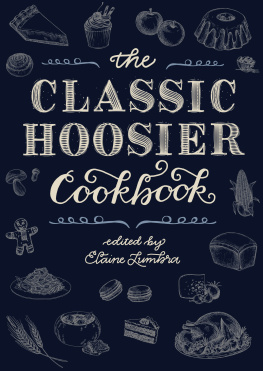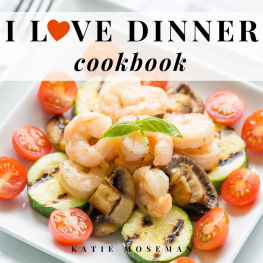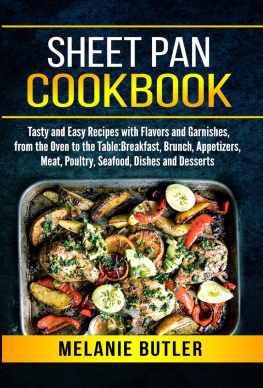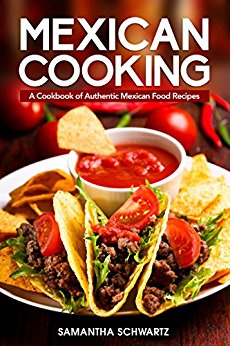 The Classic Hoosier Cookbook The Classic Hoosier Cookbook Edited by Elaine Lumbra
The Classic Hoosier Cookbook The Classic Hoosier Cookbook Edited by Elaine Lumbra  Illustrated by Jackie Lacy Indiana University Press This book is a publication of Indiana University Press Office of Scholarly Publishing Herman B Wells Library 350 1320 East 10th Street Bloomington, Indiana 47405 USA iupress.indiana.edu Quotation on page 211 is from Rachel Peden, Speak to
Illustrated by Jackie Lacy Indiana University Press This book is a publication of Indiana University Press Office of Scholarly Publishing Herman B Wells Library 350 1320 East 10th Street Bloomington, Indiana 47405 USA iupress.indiana.edu Quotation on page 211 is from Rachel Peden, Speak to
the Earth, p. 35. Copyright 1974 by Rachel Peden.
Reprinted by permission of Alfred A. Knopf, Inc. 2018 by Indiana University Press Originally published as The Hoosier Cookbook, 1976 by Indiana University Press All rights reserved No part of this book may be reproduced or utilized in any form or by any means, electronic or mechanical, including photocopying and recording, or by any information storage and retrieval system, without permission in writing from the publisher. The paper used in this publication meets the minimum requirements of the American National Standard for Information SciencesPermanence of Paper for Printed Library Materials, ANSI Z39.48-1992.
Manufactured in the United States of America The Library of Congress has cataloged the original edition as follows: The Hoosier cookbook. Includes index. 1. Cookery, American-Indiana. I. II. II.
Lacy, Jacqueline. TX715.H7855641.5'977275-31420 ISBN 0-253-13865-5 ISBN 978-0-253-03277-5 (hdbk.) ISBN 978-0-253-03343-7 (pbk.) ISBN 978-0-253-03346-8 (ebk.) 1 2 3 4 5 23 22 21 20 19 18 Contents by Mary E. Fuqua Foreword To read through Indianas bicentennial cookbook, with all of its delicious associations, is to reconstruct the states bountiful heritage. Man has cooked here for much longer than two hundred years. In lands already under cultivation the earliest explorers found prospects of wealth almost as appealing as those promised by the fur trade. Their first attempts to mix the corn, the wild game and fish, and the alien plants in the American Indians diet with the dishes of their homelands came from necessity.
But with generous dashes of French, English, Scotch-Irish, Creole, and Swiss ingenuity, Indiana pioneers and settlers rapidly made this bounty from land and water their own. The later flavors of German, Polish, Hungarian, Slavic, and Italian cooking brought cuisines of the world to Indianas kitchens. Yet how could it have evolved any other way? The ingredients were here. Indianas soils and climates promised and produced the meats, poultry, and dairy foods that are based on its famous grains. Fruits and vegetables, wild game and fish were abundant. First linked strongly to the South through its settlers, its rivers and canals, Indianas trade expanded to the Eastern Seaboard with the coming of the railroads.
Eventually, the states central location in the nations transportation system brought quickly to our markets foods that we could not produce here. The sciences of food and agriculture have played a major role in this rich heritage. The late nineteenth century saw the beginning of experimental work in agriculture that has improved farm production and farm life throughout the world. Purdue University, as part of the land-grant system, has fostered research that may alter the present world-wide problems of hunger and poor nutrition. The Cooperative Extension Service, in turn, has transformed the results of this research into practical information and applications. From its beginnings the Extension Service has provided informal education for Indiana residents.
The Indiana Extension Homemakers Association, whose members have shared their recipes in this book, includes approximately 3,000 clubs with 55,000 members. Food is one of the great joys of life. It does not take long for homemakers to transform the benefits of science into an art. Prized recipes have long been the best of the tried-and-truemothers secret ingredients, the State Fairs awards, the fastest disappearing dishes at family reunions. Even masters of haute cuisine acknowledge their debt to those who have preserved these family recipes on paper instead of carrying them, tantalizing and unreliable, in the memory. Nevertheless, the tried-and-true is changing, too.
Just as the European ethnic cuisines enlivened Indiana menus earlier, now we are even more receptive to experimentation. With the recipes of our Asian, African, and Latin-American friends, we are heading in new directions. Then, too, women are discovering that many men share their enjoyment of cooking. Young people, especially, are rekindling the pride in starting from scratch and the interest in the cooking methods and ingredients of yesteryear. We are rediscovering the need for, and the sense of achievement from, growing and preserving our own food. Have we come full circle then? In a way, yes.
Like our ancestors, we still seek the good life. If, in the vast storehouse of experience, education, and technology that we have built over two centuries, we have found some ingredients for the good life, we should certainly preserve the recipes. MARY E. FUQUA
Assistant Director
Cooperative Extension Service
Purdue University Preface Indiana means the land of the Indians. From whence came the name Hoosier? Many believe it came from the greeting, Whos Yere?, extended to visitors who might come to a cabin after dark. Others believe it began with an early contractor named Hoosier whose workers were called Hoosier men.
Still others believe it originates from the term Husher, as that term was used in reference to strong and husky men, especially rivermen, who could often hush their opponents. Whatever the origin, few will deny that the term today stands the world around for both hospitality and friendliness. With homemakers this friendliness often extends from one home to another with the exchange of a favorite recipe. There are many who believe that an unshared recipe is a poor thing. Thanks are due the over 8,000 extension homemakers, representing most of the counties in Indiana, who submitted recipes for sharing. It is sincerely regretted that space restrictions limited the number of recipes actually printed.
The pages of The Hoosier Cookbook are filled with favorite recipes which have stood the test of both time and kitchen testing and bear the endorsement of the homemaker submitting the recipe. The bits and pieces of history, Hoosier farm wisdom, and culinary folklore have been included in the hope of providing a nostalgic dimension to your recipe reading. Bloomington, Indiana ELAINE LUMBRA The Classic Hoosier Cookbook  Appetizers and Beverages
Appetizers and Beverages Eye-catching appetizers serve to stimulate both hunger and conversation. They should have character, but not be rich and filling, because they are intended to whet, not satisfy the appetite. Remember to serve cold appetizers crisp and cold and hot appetizers really hot. The offer alone of a cup of cheera cup of coffee, tea, milk, or spiritsmakes guests feel welcome.
Eye-catching appetizers serve to stimulate both hunger and conversation. They should have character, but not be rich and filling, because they are intended to whet, not satisfy the appetite. Remember to serve cold appetizers crisp and cold and hot appetizers really hot. The offer alone of a cup of cheera cup of coffee, tea, milk, or spiritsmakes guests feel welcome.
Appetizers BISCUIT CANAPES 2 pkg. large biscuits 2 sticks butter 2 4-oz. pkg. Roquefort or blue cheese Cut biscuits into halves and the halves into thirds. Melt butter in pan, add crumbled blue cheese. Spread over the bottom of a large flat pan and put biscuit pieces on top.
Bake 10 to 12 min. at 375 to 400. Makes 120 bite-size canaps.
Next page







 The Classic Hoosier Cookbook The Classic Hoosier Cookbook Edited by Elaine Lumbra
The Classic Hoosier Cookbook The Classic Hoosier Cookbook Edited by Elaine Lumbra  Illustrated by Jackie Lacy Indiana University Press This book is a publication of Indiana University Press Office of Scholarly Publishing Herman B Wells Library 350 1320 East 10th Street Bloomington, Indiana 47405 USA iupress.indiana.edu Quotation on page 211 is from Rachel Peden, Speak to
Illustrated by Jackie Lacy Indiana University Press This book is a publication of Indiana University Press Office of Scholarly Publishing Herman B Wells Library 350 1320 East 10th Street Bloomington, Indiana 47405 USA iupress.indiana.edu Quotation on page 211 is from Rachel Peden, Speak to Appetizers and Beverages
Appetizers and Beverages Eye-catching appetizers serve to stimulate both hunger and conversation. They should have character, but not be rich and filling, because they are intended to whet, not satisfy the appetite. Remember to serve cold appetizers crisp and cold and hot appetizers really hot. The offer alone of a cup of cheera cup of coffee, tea, milk, or spiritsmakes guests feel welcome.
Eye-catching appetizers serve to stimulate both hunger and conversation. They should have character, but not be rich and filling, because they are intended to whet, not satisfy the appetite. Remember to serve cold appetizers crisp and cold and hot appetizers really hot. The offer alone of a cup of cheera cup of coffee, tea, milk, or spiritsmakes guests feel welcome.